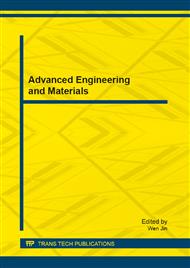[1]
A.J. Kinloch, K. Masania, A.C. Taylor, S. Sprenger andD. Egan, The fracture of glass-fibre-reinforced epoxy composites using nanoparticle-modified matrices, Journal of Materials Science. 43(2008)1151-1154.
DOI: 10.1007/s10853-007-2390-3
Google Scholar
[2]
C. Lu and P. Chen, Thermal Residual Stress Distribution in Carbon Fiber/Novel Thermal Plastic Composite, Applied Composite Materials. 15(2008)157-169.
DOI: 10.1007/s10443-008-9064-4
Google Scholar
[3]
J. Díaz and L. Rubio, Developments to manufacture structural aeronautical parts in carbon fibre reinforced thermoplastic materials, Journal of Materials Processing Technology. 143(2003)342-346.
DOI: 10.1016/s0924-0136(03)00450-3
Google Scholar
[4]
M. Dube, P. Hubert, A. Yousefpour and J. Denault, Resistance welding of thermoplastic composites skin/stringer joints, Composites Part A. 38(2007)2541-2552.
DOI: 10.1016/j.compositesa.2007.07.014
Google Scholar
[5]
P. Rosso, B. Fiedler, K. Friedrich and K. Schulte, The influence of residual stresses implicated via cure volume shrinkage on CF/VEUH-composites, Journal of Materials Science. 41 (2006)383-388.
DOI: 10.1007/s10853-005-2619-y
Google Scholar
[6]
J. L. Tsai and Y. K. Chi, Investigating thermal residual stress effect on mechanical behaviors of fiber composites with different fiber arrays, Composites Part B. 39 (2008)714-721.
DOI: 10.1016/j.compositesb.2007.05.005
Google Scholar
[7]
M. Hojo, M. Mizuno, T. Hobbiebrunken, T. Adachi, M. Tanaka and S. K. Ha, Effect of fiber array irregularities on microscopic interfacial normal stress states of transversely loaded UD-CFRP from viewpoint of failure initiation, Composites Science and Technology. 69 (2009).
DOI: 10.1016/j.compscitech.2008.08.032
Google Scholar
[8]
J.H. You, W. Lutz, H. Gerger, A. Brendel, C. Höschen, S. Schmauder, Fiber push-out study of a copper matrix composite with an engineered interface Experiments and cohesive element simulation, International Journal of Solids and Structures. 46(2009).
DOI: 10.1016/j.ijsolstr.2009.08.021
Google Scholar
[9]
G. Carlos, L.L. Javier, Mechanical behavior of unidirectional fiber-reinforced polymers under transverse compression Microscopic mechanisms and modeling, Composites Science and Technology. 67(2007)2795-2860.
DOI: 10.1016/j.compscitech.2007.02.001
Google Scholar
[10]
C. Balzani, W. Wagner, An interface element for the simulation of delamination in unidirectional fiber-reinforced composite laminates, Engineering Fracture Mechanics. 75(2008)2597-2615.
DOI: 10.1016/j.engfracmech.2007.03.013
Google Scholar
[11]
S. S. Yeong, P. J. Shailendra, K. T. Ramesh, An enhanced continuum model for size-dependent strengthening and failure of particle-reinforced composites, ActaMaterialia. 57(2009)5848-5861.
DOI: 10.1016/j.actamat.2009.08.010
Google Scholar
[12]
L. M. Jr, P. Brøndsted, Micromechanisms of damage in unidirectional fiber reinforced composites 3D computational analysis, Composites Science and Technology. 69(2009)1036-1044.
DOI: 10.1016/j.compscitech.2009.01.022
Google Scholar
[13]
J. LLorca, C. González, J. M. Molina-Aldareguía, J. Segurado, R. Seltzer, F. Sket, M. Rodríguez, S. Sádaba, R. Muñoz, and L.P. Canal, Multiscale Modeling of Composite Materials a Roadmap Towards Virtual Testing, Advanced Materials, 23(2011).
DOI: 10.1002/adma.201101683
Google Scholar
[14]
Z. Y. Jiang, H. Zhang, Z. Zhang, H. Murayama and K. Okamoto, Improved bonding between PAN-based carbon fibers and fullerene-modified epoxy matrix, Composites Part A. 39 (2008)1762-1767.
DOI: 10.1016/j.compositesa.2008.08.005
Google Scholar
[15]
F. Bouafia, B. Serier and B. A. B. Bouiadjra, Finite element analysis of the thermal residual stresses of SiC particle reinforced aluminum composite, Computational Materials Science . 54 (2012) 195-203.
DOI: 10.1016/j.commatsci.2011.10.030
Google Scholar
[16]
M. V. Rao, P. Mahajan, R. K. Mittal, Effect of architecture on mechanical properties of carbon/carbon composites, Composite Structures. 83 (2008)131-142.
DOI: 10.1016/j.compstruct.2007.04.003
Google Scholar
[17]
K. H. Lee, S. Moorthy, S. Ghosh. Multiple scale computational model for damage in composite materials, Computer Methods in Applied Mechanics and Engineering. 172(1999)175-201.
DOI: 10.1016/s0045-7825(98)00229-1
Google Scholar


